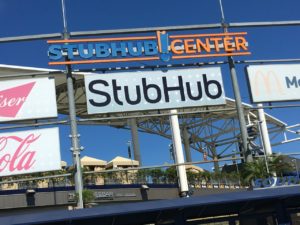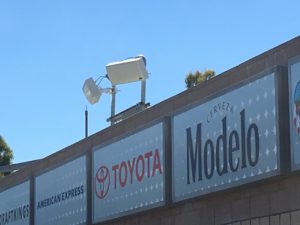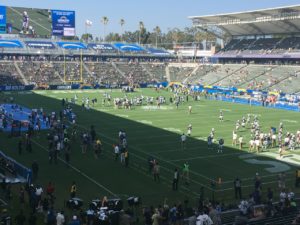
While the new LA stadium is being built, the soccer-specific StubHub Center is the home to the NFL’s Los Angeles Chargers. Credit all photos: Terry Sweeney, MSR (click on any picture for a larger image)
But StubHub Center, built on the campus of California State University/Dominguez Hills, also includes a velodrome, an 8,000-seat tennis stadium (with several adjacent courts), and an outdoor track and field facility. Throw in the far-flung parking lots and it adds up to 125 acres that all need wireless connectivity.
With such wide spaces to cover, StubHub management opted not to spend on fan-facing Wi-Fi and instead focused on distributed antenna system (DAS) technology to keep fans and tailgaters connected. Katie Pandolfo, StubHub’s general manager, looked to the major cellular carriers to invest in and support the connectivity needs of Galaxy and Chargers fans, and other eventgoers at the open-air StubHub.
Carriers help bear the cost of connectivity
Editor’s note: This profile is from our latest STADIUM TECH REPORT, an in-depth look at successful deployments of stadium technology. Included with this report is a profile of Wi-Fi at Nebraska’s Memorial Stadium, a sneak peek at Milwaukee’s new Fiserv Forum, and a profile of the new Wi-Fi network being added to Wrigley Field! DOWNLOAD YOUR FREE COPY now!
“With our DAS-only approach, the investment is 100 percent on the carriers and doesn’t cost us anything,” Pandolfo told Mobile Sports Report. While they got a few complaints about no public Wi-Fi during events in 2017, when the 29-zone DAS system was activated, fans quickly acclimated and now use bandwidth from Sprint, T-Mobile and Verizon on the shared network. AT&T isn’t part of the DAS system, but has operated a macro site at StubHub for years, according to Pandolfo.Mobilitie helped build StubHub’s DAS system and offered its engineering expertise; the turnkey provider also manages the system. The DAS-only approach is common in southern California; in addition to the Rose Bowl in Pasadena, the Honda Center in Anaheim and Viejas Arena (under construction) at San Diego State University are also DAS-only venues with no fan-facing Wi-Fi.
StubHub Center, located in Carson, Calif., is 17 miles south of downtown Los Angeles, and upwind from a nearby Goodyear blimp mooring station; gusty coastal winds apparently make this a good training ground for new blimp pilots. The 27,000-seat StubHub originally opened in 2003 as Home Depot Center; the new sponsor came onboard in 2013. Anschutz Entertainment Group owns and operates StubHub Center.
StubHub will handle several events when Los Angeles hosts the Summer Olympics in 2028, including bicycle track racing, field hockey, pentathlon, rugby and tennis. Pandolfo expects firmer plans for the venue’s technology needs to emerge sometime in the next couple years. Technology – especially wireless technology – will change a lot in that time, she noted.
As the second soccer-specific stadium built in the U.S., Major League Soccer’s LA Galaxy is the venue’s premier tenant. But in 2017 when the National Football League’s Chargers moved from San Diego to Los Angeles, the facility underwent some major upgrades. Additions include 1,000 new tip-up seats replacing bleachers on the east side of the stadium; another 330 bleacher seats were added in StubHub’s southeast corner. Luxury suites and the press box were renovated along with two new radio booths; they also added a security office for police and NFL officials, and camera booths at the two 20-yard lines and at the 50-yard line. Locker rooms were enlarged as was the press conference room.
And tempting as it may be to lump all fans of any sport into a single heap, Pandolfo said Galaxy fans and Chargers fans behave very differently at StubHub Center. Chargers fans like to get up and walk around, visit concessions and take advantage of the venue’s amenities during the game. Not so for Galaxy fans, who tend to stay seated and don’t want to miss any of the action, she explained.California’s Department of Alcoholic Beverage Control also just changed its rules and will now allow beer sales up and down the aisles of stadiums like StubHub Center. Beer hawking, she noted, didn’t used to be digital and required fans to pay cash. “Now it’s a quicker transaction that improves the fan experience,” using mobile pay systems or credit cards, Pandolfo said.
DAS upgrades mean faster speeds
In the meantime, Mobilitie continues to optimize StubHub’s DAS system; based on bandwidth speed tests conducted by Mobile Sports Report, things are moving in the right direction. MSR tested Verizon DAS connectivity right after the system was installed in August 2017, and a year later during a Chargers’ pre-season game against New Orleans. In 2017, Verizon’s DAS struggled in single-digit Mbps uploads and downloads; quite often, the throughput was even less.
What a difference a year makes. Mobilitie engineers’ fine-tuning has paid off; August 2018 tests show dramatic improvement, with the highest throughputs near the stadium’s northwest concessions area — 111.39 Mbps/12.15 Mbps (download/upload). A year previous, things were a lot more sluggish with 0.95 Mbps/0.04 Mbps speeds recorded in the same area.
DAS performance has also improved just inside the gates past the ticket scanners at the bottom of the stairs; in 2017, we clocked only 1.87 Mbps/13.42 Mbps, but more recently throughput had jumped to 87.08 Mbps/21.42 Mbps. The concession area on the east side of the stadium checked in most recently at 76.55 Mbps/6.7 Mbps, another sizeable increase from last year when Verizon DAS throughput was a pokey 0.4 Mbps/0.06 Mbps.Speeds inside the stadium have also improved year-over-year. Section 230 in the northeast corner of StubHub measured 2.83 Mbps/1.96 Mbps a year ago, but were up to 13.48 Mbps/8.71 Mbps in August 2018. Similarly, the sunny northern end of the stadium above the end zone delivered 0.21 Mbps/0.27 Mbps a year ago, but jumped to a more acceptable 16.44 Mbps/18.27 Mbps. The east side of the stadium is also more robust; a year ago, bandwidth tests yielded 3.1 Mbps/0.01 Mbps, but were up to 8.97 Mbps/1.74 Mbps.
Improvements to the DAS network performance can only help improve the fan experience at StubHub Center. Pandolfo wants fans to be able to do everything faster: Get parked faster, enter the stadium, and take advantage of all the food, drink and merchandise options. “We look at the whole package and then at the network we have to provide to make that happen,” she said. “We’re looking at it from the fan experience but also how to optimize revenue for the building.” It’s the right formula for sporting venues compelled to balance technology requirements against dollars and cents.









